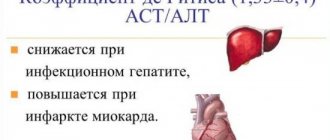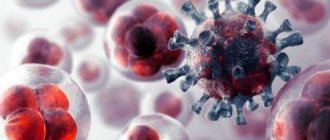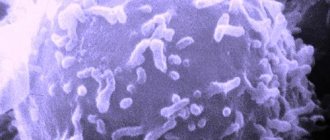Albumin in blood test
Biochemical blood test is one of the most informative diagnostic methods.
The results obtained allow us to assess the general condition of the body and the degree of functionality of the internal organs. In laboratory conditions, each component element of a biological fluid is assessed. The leading positions in the blood biochemistry assessment table are occupied by total protein and protein fractions represented by albumin, globulins, and fibrinogen. Albumin accounts for more than 60% of the total plasma. Evaluation of the results of microscopy of all blood elements is carried out by comparing the data obtained with reference values (average norm).
If albumin in the blood is elevated, the term hyperalbuminemia is used; a reduced amount is defined as hypoalbuminemia. The percentage of other protein fractions (globulins) in the blood plasma is as follows: alpha 1 (α1) - from 2 to 5%, alpha 2 (α2) - from 7 to 13%, beta (β) - from 8 to 15%, gamma (γ) –12 to 22%.
Preparing for analysis
A laboratory test for serum albumin is performed as part of a blood chemistry test. The training requirements are standard; a detailed description of them is given here.
However, given the high ability of protein to bind, it would not be amiss to recall that a few days before the procedure it is necessary to stop taking any medications, and to exclude fatty, fried foods and alcohol from the diet.
Sources:
- Spinella R, Sawhney R. Albumin in chronic liver disease: structure, functions and therapeutic implications. — Hepatology International, Sep 2020.
- Data from the independent laboratory Invitro.
- Data from Helix laboratory.
- Sridevi Devaraj. Albumin. — Medscape, Jan 2020.
The role of albumin in the body
Albumin is a protein product of the intrasecretory activity of hepatocytes (liver cells). The volume of production of the protein fraction is 13–18 g/day. For convenience, the study separates serum albumin (serum), contained in plasma, and spinal albumin, located in the fluid of the intercellular space (interstitial) and spinal cord fluid.
The molecular structure of albumin consists of numerous amino acids synthesized directly in the body. The time interval for the vital activity of the protein fraction varies from 15 to 20 days. Circulating throughout the body with the general bloodstream, albumin is responsible for several important biological processes.
- Maintaining a stable level of colloid-osmotic (otherwise, oncotic) pressure, which regulates water metabolism in the body, retains fluid in the bloodstream, and controls the process of water absorption from the intestine.
- Delivery to destination and distribution of biologically active substances (adrenal and thyroid hormones), organic compounds, acids, vitamins and minerals.
- Transportation of certain medications (lipid hormones, penicillin, etc.).
- Binding and neutralization of substances hazardous to health (low-density lipotropes, free bilirubin, heavy metal salts).
- Preventing erythrocytes (red blood cells) from destruction by binding fatty acids and cholesterol.
- Protection of the endothelium (inner layer of blood vessels) from the formation of atherosclerotic growths.
- Maintaining a dynamic balance of ionized calcium through correlation with regular calcium entering the body.
- Prevention of fatty hepatosis (degeneration of hepatocytes into adipose tissue).
- Participation in the construction of new muscle tissue proteins (proteins).
- Ensuring the body's amino acid reserve (in case of insufficient food intake).
Albumin in a biochemical blood test primarily reflects the level of liver and kidney capacity. In addition, fluctuations in the protein fraction are taken into account when diagnosing cancer. The medical prescription of biochemical analysis should not be neglected. Timely detection of pathological abnormalities in blood parameters makes it possible to diagnose the disease at an early stage of its development.
What it is
Albumin is a water-soluble protein in the blood produced in large quantities by the liver and has a lifespan of approximately three weeks. Albumin protein consists of essential amino acids that are synthesized in the human body and cannot be obtained from the outside.
Protein albumin
The most important functions performed by the liver:
- Cleansing the body of toxins and poisons.
- Production of hormones, enzymes, blood elements, including whey protein - albumin.
More than half of the protein in human blood is albumin. It easily binds to substances necessary for the functioning of the body (hormones, fatty acids, vitamins and microelements, drugs) and, since these elements cannot be transported on their own, albumin carries them through the bloodstream, delivering them to the tissues. One of the functions of albumin is transport.
A uniform, stable amount of albumin maintains the necessary osmotic pressure and normal plasma content in the bloodstream. When the concentration decreases, plasma escapes into the surrounding tissues and the consistency of the blood is disrupted. Swelling occurs when tissues are starved.
Blood plasma albumin is a depot of vital essential amino acids that are used to build cells and are used by the body during periods of lack of protein intake. In the absence of health problems, the amount of albumin in the blood is a fairly stable indicator. Fluctuations in the level of this protein are extremely undesirable for the body.
Albumin content analysis
Albumin levels are determined in a blood test when checking its general biochemical composition. In some cases, the doctor may prescribe a separate microscopy procedure only to assess the content of protein fractions. The main indications are:
- functional disorders of the renal apparatus;
- liver diseases;
- malignant tumors;
- digestive disorder caused by insufficient absorption of nutrients by the intestines (malabsorption);
- some infectious diseases.
Blood sampling is carried out in a medical institution. Before the procedure, the patient must follow the following rules: avoid fatty foods 2-3 days before the test, fast for at least eight hours, and exclude sports training and other physical activities on the eve of the procedure.
Reference values of the substance in the blood
The concentration of albumin in the blood depends on age-related changes that occur in the body during a given period of development. At the same time, during certain periods of life, the indicators of the protein fraction in the serum increase, then decrease and then increase again. The average norm of the albumin fraction for an adult over 21 years of age (regardless of gender) is considered to be from 40 g/l to 50 g/l.
The results of the analysis are not grouped by gender, since the level of albumin in the blood of men and women is the same. The exception is the perinatal and lactation periods, when the concentration of blood protein in women is reduced. After delivery and the breastfeeding period, albumin levels should return to reference values.
In people over 60 years of age, low albumin in the blood is not considered a pathology. This is due to a decrease in the functional ability of hepatocytes to synthesize protein. The standards for children have a more detailed gradation by age. Separation is associated with periods of intense child growth.
| First week of life | From one week of age to one year | From one year to 5 years | From 5 to 8 years | Schoolchildren from 8 to 11 | Teenagers from 11 years to adulthood |
| 32,5-40,7 | 33,6 -42,0 | 33,6-43,0 | 37,0-47,1 | 40,6-45,6 | 38,9-46 |
In premature babies, blood albumin standards range from 18 to 30 g/l. Slight variation of reference values is allowed, depending on the laboratory in which the study is carried out. Decoding of digital values is carried out by a medical specialist who referred the patient for blood biochemistry.
Deviations from the norm and their causes
The level of albumin in the blood can be disturbed in the direction of its increase or decrease. Deviations from the standards may not be accompanied by obvious psychosomatic symptoms, so they are often determined during medical examination, on the patient’s own initiative or as part of a general biochemical analysis prescribed by the therapist.
Increased levels of albumin fraction
High levels of protein cause dehydration (dehydration). This condition develops as a result of hyperthermia caused by intense thermal effects on the body, or intoxication (poisoning). Hyperalbuminemia as an independent diagnosis is rare, but can accompany the following acute and chronic diseases:
- acute intestinal infection from the anthroponotic group (cholera);
- various diseases of infectious origin;
- disruption of the movement of food through the digestive tract (intestinal obstruction);
- a group of autoimmune diseases (systemic lupus erythematosus, multiple sclerosis, Crohn's disease, etc.);
- cirrhosis of the liver;
- systemic damage to the connective tissue of small joints (rheumatoid arthritis);
- blood cancer;
- infectious inflammatory kidney disease (pyelonephritis);
- diabetes;
- hepatitis;
- burn lesions of the epidermis (skin) and deeper tissues;
- incorrect therapy with hormone-containing drugs.
Elevated albumin levels do not require drug therapy; the disease against which a deviation from the norm is detected should be treated. With separately diagnosed hyperalbuminemia, the following help reduce protein levels:
- Diet correction. It is necessary to minimize the amount of protein products (meat, fish, mushrooms, eggs) and simple carbohydrates (confectionery, sweet drinks) in the menu. Avoid cooking food by frying.
- Quitting nicotine addiction and alcoholic beverages.
Decreased performance
A low level of albumin fraction in plasma is recorded at values ⩽ 25 g/l. There are physiological and pathological hypoalbuminemia. A physiological decrease in protein occurs in women in the third trimester of the perinatal period due to the need to provide nutrition to two organisms. If during screening a biochemical analysis of an expectant mother shows values from 30 to 35 g/l, this is not considered a pathological deviation.
Albumin levels may be reduced by forced fasting in the postoperative period or by using aggressive weight loss techniques that exclude protein foods. In these cases, albumin deficiency can be compensated for by proper nutrition. If hypoalbuminemia is pathological, it means that there are disorders or pathologies in the body, accompanied by a decrease in the concentration of protein in the blood plasma.
The main causes of albumin deficiency:
- neoplasms of oncological nature;
- diabetic glomerulosclerosis (transformation of living kidney tissue into connective tissue) and diabetic nephropathy (damage to the vessels of the renal apparatus);
- inflammatory disease of the renal glomeruli (nephritis);
- infectious and toxic hepatitis;
- hepatic decompensation, liver cirrhosis;
- overhydration (excessive fluid content in the body);
- leukemia (blood cancer) and sepsis (blood poisoning);
- chronic pathologies of the gastrointestinal tract (gastrointestinal tract), including malabsorption;
- cardiac decompensation;
- systemic inflammatory disease of connective tissue (acute rheumatic fever, otherwise rheumatism);
- heavy blood loss;
- pulmonary insufficiency with accumulation of fluid in the alveoli (pulmonary edema);
- thermal, chemical, electrical burns of a wide area and depth;
- eczema herpetiformis and some types of chronic dermatoses;
- chronic alcoholism;
- uncontrolled use of antibiotics and non-steroidal anti-inflammatory drugs (NSAIDs).
A decrease in albumin levels can be caused by therapy with hormone-containing medications. Newborns are diagnosed with hypoalbuminemia due to immaturity of the liver cells and congenital genetic abnormalities of the albumin structure. Pathologically low albumin is restored with the correct treatment tactics for the underlying disease. The patient needs to undergo additional examination to determine the cause of deviations from the norm.
If a biochemical analysis shows low protein values, but the person does not have chronic or acute diseases, a low-carbohydrate diet will help increase albumin concentration. It is recommended to increase the amount of protein in the diet by reducing simple carbohydrates and fats, limit the use of table salt, and eliminate alcoholic beverages.
In cases where the level of the albumin fraction is reduced to critical values, but this does not have pathological reasons, intravenous injections of the drug Human Albumin 20% are prescribed. The dosage of the medicine is determined by the doctor, taking into account the individual characteristics of the patient. Liver herbal tea is used as an adjunct to normalize protein. The pharmacy chain offers several options for medicinal preparations, so you should consult your doctor before purchasing.
Additionally
If abnormalities in the protein content in the blood are detected, laboratory microscopy of urine is prescribed. Albumin is filtered by the renal apparatus (tubules and glomeruli). The daily rate of total protein in urine should be within the range of 30–300 mg/l, of which albumin makes up no more than 30 mg/l. An increase in indicators is diagnosed as microalbuminuria - one of the clinical signs of nephritis, pyelonephritis, nephropathy and other kidney diseases.
What are the main reasons for decreased serum albumin concentration?
A condition in which there is a decrease in plasma albumin below 35 g/l is called hypoalbuminemia. The leading clinical symptom of this pathological process is the development of oncotic edema, because a small amount of albumin becomes unable to hold the required amount of water within the vascular bed.
A decrease in albumin levels can be physiological, that is, caused by a special transient state of the body, or pathological, which reflects disturbances in the functioning of various organs and tissues.
Physiological hypoalbuminemia occurs in women in the 3rd trimester of pregnancy and during breastfeeding (due to the significant needs of the mother and fetus), and in infants (due to the immaturity of the sources of plasma protein formation).
The main causes of low albumin levels (pathological hypoalbuminemia) include:
- Lack of receipts. It is observed with prolonged fasting, tumors of the esophagus, and an unbalanced diet. Since it is albumin that plays the role of the first reservoir of amino acids, in case of their external deficiency it is used for the synthesis of various protein molecules depending on the needs of the body;
- Malabsorption syndrome. Malabsorption of nutrients can be caused by various reasons: hereditary pathology, inflammatory diseases of the gastrointestinal tract (enteritis), autoimmune diseases (Crohn's disease), enzymatic deficiency (pancreatitis), etc.;
- Genetic diseases. As an independent cause of a decrease in albumin concentration, it is extremely rare, but can lead to an almost complete absence of albumin in the blood serum (analbuminemia). In this case, the remaining protein fractions take over their functions;
- Kidney pathology (nephrotic syndrome). In this case, there is a decrease in the concentration of albumin in blood biochemistry below 20 g/l. The cause is damage to the glomerular apparatus of the kidneys (glomerulonephritis), in which the loss of albumin through the urinary system sharply increases. The diagnostic criterion is the detection of protein in the urine: more than 3.5 g/day;
- Liver diseases. Most often, hypoalbuminemia develops with liver cirrhosis of various origins: alcoholic, viral, toxic, cardiac. This occurs due to the defective functioning of liver cells (hepatocytes), which are not able to produce albumin in sufficient quantities. The amount of its daily synthesis decreases by 2-3 times: from 10-15 to 4-5 grams per day. However, changes in biochemical blood tests are diagnosed only 2-3 weeks after liver damage.
- Malignant neoplasms. Tumor processes actively have the properties of enhanced metabolism, which means they intensively consume nutrients. This may cause plasma albumin concentrations to decrease below normal levels. Direct damage to hepatocytes by a tumor or metastases from various organs is also possible.
- Diffuse connective tissue diseases. Accompanied by hypoalbuminemia as a result of direct and indirect (by damage to the kidneys and liver) metabolic disorders. Systemic diseases are characterized by a parallel decrease in albumin levels with an increase in the globulin fraction (systemic lupus erythematosus, dermatomyositis, rheumatoid arthritis), i.e. the albumin-globulin index is reduced;
- Burn disease. One of the first manifestations of extensive burns is a decrease in serum albumin concentration due to its generalized breakdown, which may require albumin transfusion;
- Massive bleeding. Lead to the rapid release of all types of protein beyond the circulatory system. The severity of hypoalbuminemia correlates with the rate of blood loss;
- Dermatological diseases (Lyell's syndrome, exfoliative dermatitis, severe forms of eczema). Accompanied by increased consumption of albumin, similar to burn damage to the skin;
- Taking certain medications (combined oral contraceptives, estrogen-containing hormones);
- Enhanced protein breakdown. Albumin is reduced due to increased intensity of metabolic processes in thyrotoxicosis, septic conditions, prolonged fever, Itsenko-Cushing's disease, preeclampsia, etc.
Article on the topic:
What is somatotropic hormone (growth hormone)?
In the above cases, hypoalbuminemia is absolute. When fluid is retained in the bloodstream, a relative (untrue) decrease in the concentration of serum albumin may be observed. Examples include poor kidney function in chronic renal failure and hormonal disorders (hyperaldosteronism).
The detection of albumin in urine using special tests has important prognostic significance. Normally, the kidneys excrete up to 30 mg of this protein per day. An increase in excretion up to 300 mg is not identifiable by standard methods of general urine analysis and is not reflected in a biochemical blood test. However, it is in this range that the initial signs of damage to the glomerular apparatus of the kidneys develop in arterial hypertension and diabetes mellitus. The appearance of microalbuminuria indicates an unfavorable course of the pathological process.
What does albumin show in a biochemical blood test? Causes of high and low albumin
The level of albumin in the blood is determined using a biochemical analysis. Overestimated or underestimated indicators of a substance obtained by fractionation indicate a pathological process in the body.
Albumin or protein fractions are the most common indicators studied, because the substance reflects how fully the liver functions in protein synthesis.
Interesting fact: within 2 days the liver produces 15 grams of albumin, which provides benefits for up to 20 days.
Promotion
An increased level of albumin in women and men is observed during dehydration, in diseases accompanied by diarrhea and frequent vomiting, for example, severe viral infection, influenza. As a result of fluid loss and an increase in albumin concentration, blood thickening occurs in large wound or burn surfaces.
Much more common is a low level of albumin in the blood. A lack of protein may be due to its low production or increased excretion.
The most common causes of a decrease in albumin concentration in the body that are not the result of diseases:
- “Sitting” on strict diets leads to the consumption of protein from reserves, which provokes the development of dystrophy.
- Smoking and alcoholism have a detrimental effect on liver cells, which accordingly reduces the production of albumin.
- Uncontrolled use of medications such as anti-inflammatory drugs, analgesics, oral contraceptives.
- In pregnant women, the need for protein and its consumption are higher, since the fetus needs building material, and it can only take it from the mother’s body. The same changes are observed during breastfeeding.
- There is a genetic predisposition to low albumin levels, reasons, but the person feels absolutely normal.
Albumin - what is it in a biochemical blood test?
Albumin is the main protein in the blood, making up more than half (50 to 65%) of the total plasma. It is synthesized by the human liver and is located in the peripheral blood, lymph, cerebrospinal and interstitial fluid. The life span of albumin lasts 15-20 days. The protein compound is low molecular weight, although the blood plasma protein fraction reserves more than 600 types of amino acids.
Based on the results of a biochemical blood test and the content of albumin in the blood serum, the doctor diagnoses the functioning of the kidneys and liver. A decrease in the concentration of a protein compound indicates the presence of rheumatism and malignant tumors.
In the picture: molecular structure of human serum albumin
Albumins are the most important elements in the blood serum, thanks to which the body functions fully.
Proteins circulate in the bloodstream and perform the following functions:
- The most important function of the protein fraction is the connection and transportation of various substances - hormones, acids, fats, bilirubin, calcium, tissue compounds.
- Responsible for maintaining blood plasma pressure , so that the fluid does not cause swelling and does not penetrate connective and muscle tissue.
- The reserve purpose is the preservation of protein elements . Albumin molecules are responsible for the preservation of amino acids necessary for the proper functioning of the body. During prolonged fasting, amino acid reserves are depleted.
Attention! Do not ignore your doctor’s recommendations regarding taking a biochemical test. Thanks to blood biochemistry, pathologies associated with albumin fluctuations are diagnosed. Timely testing helps prevent the development of pathology and prescribe effective treatment.
Albumin: normal in blood
The norms of the albumin fraction in the blood range from 35 -33 g / l, this is much higher than the content of gamma globulin (8.0 - 12.0 - 17.0 g / l) and fibrinogen (2.0 - 4.0 g / l). l), and fibrinogen is difficult to detect in blood serum.
Protein standards are set depending on the age category of people. When taking the test, the normal level in plasma is the same in a man and a woman, so the doctor relies on the albumin norm based on the patient’s age.
Pictured: Proportions of proteins in human blood
Below are blood standards depending on the age category of patients:
- Children from birth to 3 years - 25 - 50 g / l;
- Children from 3 to 14 years old - 38 - 54 g / l;
- 14 – 60 years – 33 – 55 g/l;
- Elderly people over 60 years old - 34 - 48 g / l.
It is worth noting that: in people of mature age, a decrease in the level of albumin in the blood is noticed.
Table of norms by age
| Age | Albumin, g/l | α1, g/l | α2, g/l | β, g/l | γ, g/l |
| From 0 to 7 days | 32,5 – 40,7 | 1,2 – 4,2 | 6,8 – 11,2 | 4,5 – 6,7 | 3,5 – 8,5 |
| From 1 week to a year | 33,6 – 42,0 | 1,24 – 4,3 | 7,1 – 11,5 | 4,6 – 6,9 | 3,3 – 8,8 |
| From 1 year to 5 years | 33,6 – 43,0 | 2,0 – 4,6 | 7,0 – 13,0 | 4,8 – 8,5 | 5,2 – 10,2 |
| From 5 to 8 years | 37,0 – 47,1 | 2,0 – 4,2 | 8,0 – 11,1 | 5,3 – 8,1 | 5,3 – 11,8 |
| From 8 to 11 years | 40,6 – 45,6 | 2,2 – 3,9 | 7,5 – 10,3 | 4,9 — 7,1 | 6,0 – 12,2 |
| From 11 years to 21 years | 38,9 – 46,0 | 2,3 – 5,3 | 7,3 – 10,5 | 6,0 – 9,0 | 7,3 – 14,3 |
| After 21 years | 40,2 – 50,6 | 2,1 – 3,5 | 5,1 – 8,5 | 6,0 – 9,4 | 8,1 – 13,0 |
Normal blood albumin levels in women
Examining the biochemical analysis of the blood of a pregnant woman, a decrease in the concentration of protein in the plasma is noticed. The normal albumin content during pregnancy and lactation is 30-34 g/l.
After childbirth and at the end of breastfeeding, the level of protein compounds in the female body is normalized to the usual values.
Important information! An increase or decrease in albumin is caused by external and internal factors and indicates a pathogenic process in the body of a female representative.
Sometimes the lack of protein is caused by physiological characteristics, because proteins are released into the body of the expectant mother and reach the fetus. A balanced diet and proper rest help normalize albumin in a pregnant woman.
Normal blood albumin levels in men
The normal albumin level in middle-aged males is 33 - 55 g/l.
Albumin norm in children
Children's indicators also depend on age and the younger the child, the lower the albumin content in the blood:
- 0 - 7 days - 32.5 - 40.7 g/l;
- 7 days - 12 months - 33.6 - 42.0 g/l;
- 1 year - 5 years - 33.6 - 43.0 g/l;
- 5 - 8 years - 37.0 - 47.1 g/l;
- 8 - 11 years - 40.6 - 45.6 g/l;
- 11 years - 21 years - 38.9 - 46 g/l.
In boys and girls over 21 years of age, the concentration of protein compounds in the blood varies between 40.2 - 50.6 g/l.
Attention! Reference values in analyzes performed in different laboratories are different. If there is any doubt about the result of a biochemical test, it is suggested to re-donate blood in another medical institution.
Norm of protein fractions in blood serum
| Protein fractions in blood plasma | Norm, g/l | Group ratio, % |
| Total protein | 65 – 85 | |
| Albumen | 35 — 55 | 54 — 65 |
| α1 (alpha 1) globulins | 1,4 – 3,0 | 02.05.2018 |
| α2 (alpha-2)-globulins | 5,6 – 9,1 | 01.07.2013 |
| β (beta)-globulins | 5,4 – 9,1 | 01.08.2015 |
| γ (gamma)-globulins | 8,1 – 12,0 | 01.12.2022 |
| Fibrinogen* | 2,0 – 4,0 |
If albumin is elevated in the blood, what does this mean?
If, according to the results of biochemistry, there is a noticeable increase in albumin levels, hyperalbuminemia is stated, which most often indicates dehydration (dehydration) of the body.
Frequent attacks of vomiting and prolonged diarrhea contribute to a pathological decrease in fluid in the body. This causes blood thickening and has a negative impact on health.
Another reason for elevated protein levels is extreme fatigue.
Elevated albumin levels are rarely diagnosed.
But when hyperalbuminemia is diagnosed, the following diseases are diagnosed:
- damage to the gastrointestinal tract by Vibrio cholera;
- infectious diseases;
- intestinal obstruction;
- systemic lupus erythematosus;
- plasmacytoma;
- rheumatoid arthritis;
- pyelonephritis;
- diabetes;
- hepatitis, liver cirrhosis;
- chemical, thermal or radiation damage to the skin;
- long-term use of potent medications - glucocorticosteroids or bromsulfalein.
To reduce protein, it is recommended to follow certain non-drug methods:
- adhering to a diet with low-calorie foods , avoiding foods high in proteins and carbohydrates, focusing on boiled, stewed, steamed foods with the exception of fried, salty, spicy foods;
- stop drinking alcohol , since a kidney damaged by alcohol is not able to produce complete synthesis and absorption of proteins;
- stop smoking - heavy smokers have an increased risk of developing hypertension, which affects the excessive levels of albumin in the blood. Experts advise gradually quitting smoking, otherwise the condition may become more complicated;
- drink plenty of fluids - at least 2 liters per day to avoid dehydration and blood clots.
If there is no improvement in the analysis, the doctor prescribes the use of medications using drugs from the group of inhibitors or drugs that accelerate the regulation of cholesterol synthesis in the body.
Lowering values
In European practice, it is customary to distinguish the following conditions in which albumin values can be reduced:
- Ascites;
- Extensive burns and injuries;
- Glomerulonephritis;
- Liver diseases, hepatitis,
- cirrhosis,
- carcinoma,
- hepatic encephalopathy;
- starvation;
In Russian laboratories (Invitro and Helix), the interpretation of low albumin includes, in addition to the above conditions, the following:
- The presence of exudates and transudates (edematous fluid of an inflammatory and non-inflammatory nature, respectively);
- Condition after blood transfusion and severe bleeding;
- Increased catabolism (energy metabolism) of proteins: febrile syndrome;
- infections, sepsis (blood poisoning);
- endocrine disorders (thyrotoxicosis);
- some cancers;
- rheumatic lesions;
- increase in circulating blood volume (hyperhydration);
- analbuminemia (hereditary pathology characterized by a critical decrease in the amount of albumin in the blood);
- heart failure with congestion;
- treatment with hormonal drugs, amiodarone, taking high doses of steroid hormones, growth hormone, insulin;
- pregnancy.
Low albumin: causes
When the albumin content decreases and reaches 25 - 30 g/l, hypoalbuminemia is stated.
A reduced protein concentration indicates conditions such as:
- malignant process in the body;
- inflammatory kidney disease - diabetic nephropathy, nephrotic syndrome;
- diseases of the digestive system;
- leukemia, blood sepsis;
- dysfunction of the cardiovascular system;
- functional liver disorders - atrophy, cirrhosis, hepatitis;
- connective tissue damage;
- presence of severe injuries, burns;
- excessive water content in the body;
- pulmonary edema;
- severe blood loss, transfusion of blood substitutes;
- genetic pathologies due to which albumin levels decrease;
- prolonged fasting caused by adherence to low-protein and unbalanced diets.
Other reasons why albumin levels decrease:
- taking certain medications, especially in case of overdose;
- alcohol and tobacco abuse.
If your albumin level is elevated, do not panic and do not look for illness.
Reduced protein levels in biochemical analysis appear as a result of taking estrogen-containing drugs, fasting and the use of glucocorticosteroids.
After receiving the results, contact your doctor to schedule additional tests.











